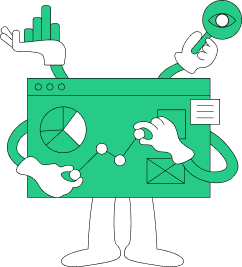In the ever-evolving digital landscape, the art of web design is like a vibrant tapestry, woven with an array of colors, patterns, and textures that bring the virtual world to life. Visitors often glide through this digital canvas with ease, unaware of the meticulous planning and strategic intricacies that form the cornerstone of an engaging online experience. There’s a common belief that web design is a simple endeavor—a straightforward task of piecing together pleasing aesthetics and a sprinkling of functionality. Yet, this craft is far more complex, a delicate balance of form and function, often misunderstood by those not intricately involved in its creation.
Beneath the surface of sleek interfaces and seamless navigation lies a myriad of misconceptions that lead to undervaluing the profound expertise required to construct an impactful web presence. The misconception that web design is solely about creating a visually appealing layout obscures the nuanced psychological play and user behavior analysis that shapes every element. With a knowing smile, seasoned designers navigate the labyrinth of user experience, search engine optimization, and mobile responsiveness—each a vital thread in the rich tapestry of web design that is frequently underestimated by onlookers enchanted by the final display.
The Misconception of Quality in Web Design
In the vast expanse of the digital cosmos, poor quality websites lurk like shadowy alleyways, deterring visitors with their unwelcoming ambiance. Conversely, a highperforming website acts as a beacon of light, inviting and guiding users with its seamless functionality and captivating design. A professionallooking website stands as a testament to credibility, transforming browsers into loyal customers and serving as a highperforming launchpad for businesses to soar. With each click, a phenomenal website weaves a narrative of trust and expertise, crafting an unspoken promise of quality, elevating the brand into a best possible website.
The Reality of Poor Quality Websites
As dawn breaks on the digital horizon, one cannot overlook the stark contrast between the polished realms of cyberspace and the derelict corners where low quality websites languish. Within these murky recesses, pages laden with cluttered interfaces, broken links, and outdated aesthetics repel visitors like cobwebs in an abandoned house. The reality of these digital deterrents is not merely a visual displeasure but a profound hindrance to user engagement and retention. With every pixel out of place, potential customers drift away, unimpressed and uncertain of the credibility behind the screen.
A highperforming launchpad website, on the other hand, acts as a beacon of trust and efficiency, but the journey to such heights begins in the trenches of the Internet’s less polished enclaves. Here, functionality stutters and content lacks coherence; these are the telltale signs of a low quality websit that fumbles the opportunity to become a profitable ai side hustl.
The Impact of High-Performing Websites
As we navigate away from the choppy waters of underwhelming web design, let’s anchor ourselves in the realm of top-tier online platforms. Imagine stepping into a digital space where every click provides instant gratification and seamless transitions; this is the compelling universe of high-caliber websites. These virtual beacons of excellence not only captivate visitors with their stunning aesthetics and intuitive navigation but also significantly boost the credibility and trustworthiness of the brand they represent.
A well-crafted website operates like a silent, tireless salesperson, greeting and guiding potential customers around the clock. The swift load times, mobile responsiveness, and accessible content structure work harmoniously to create a frictionless user experience. In this paradise of pixels, each element coalesces to elevate user engagement, reduce bounce rates, and, most importantly, convert casual browsers into loyal customers.
Such an optimized online presence can be a game-changer, transforming a humble digital footprint into a lucrative venture. Indeed, it could even serve as a profitable AI side hustle, earning while you sleep.
How a Professional-Looking Website Can be Profitable
Shifting gears, let’s delve into the tangible benefits that a well-crafted online presence can yield. Imagine a storefront meticulously designed, where every element invites passersby to step inside and explore. This is the essence of a website crafted with care and precision, serving as a digital beacon to potential customers.
A website that exudes professionalism stands as a testament to the credibility of the brand it represents. Visitors are greeted with a harmonious blend of aesthetics, functionality, and user-friendly navigation that whispers promises of quality and reliability. Such an online presence casts a magnetic spell, drawing in curious eyes and transforming them into loyal patrons.
The alchemy of turning visitors into customers lies in the details—the seamless integration of form and function, the subtle interplay of color and typography. A website that speaks the language of finesse not only enchants its audience but also opens the floodgates to increased revenue.

The Custom Website Misconception
In the bustling digital marketplace, custom websites stand as beacons of uniqueness, heralding brands with a flourish of personal flair. These personalized websites, crafted with meticulous care, often overshadow the murmurs about the worth and accessibility of DIY website tools. As artisans in the virtual space weigh the merits of custom websit creation, the allure of new websites tailored to specific needs becomes apparent.
Yet, the role of DIY website tools cannot be dismissed; they offer a canvas for creativity and an avenue for those seeking to etch their digital presence without deep pockets.
Assessing the Value of Custom Websites
As we peel away the layers of misconception in web design, the allure of custom websites beckons with the promise of a digital masterpiece tailored to precise specifications. Assessing the value of these bespoke online creations involves a careful analysis of their impact and effectiveness in a cluttered digital landscape.
Custom websites stand as a testament to originality, often setting the benchmark for what constitutes a great website. Each stroke of design and code is like a brush on canvas, painting a picture that resonates with the brand’s unique voice and mission. It’s the subtle nuances—a responsive layout, an intuitive user interface, or an immersive user experience—that elevate a website above a competitor’s site.
The investment in custom websites goes beyond aesthetics; it’s about crafting a digital presence that’s intricately aligned with one’s business strategy. For those who aim to stand out, like the important news websites that shape public opinion, the value lies in creating a platform that’s both informative and visually compelling.
Yet, the decision to embark on the website build process is not one to be taken lightly.
The Role of DIY Website Tools
As the curtain falls on the topic of quality in web design, it lifts to reveal a stage where DIY website tools play their part in the grand theater of online presence. Imagine a world where the mystique of custom websites is within grasp, not through high-cost development, but through the use of intuitive online platforms. These tools, brimming with templates and drag-and-drop features, invite businesses to craft their digital facade without the need for extensive coding knowledge.
In the bustling marketplace of the internet, these tools stand like kiosks, offering passersby the ingredients to bake their own slice of the digital pie. Whether it’s important news websites seeking to disseminate information or the best local WordPress development looking to shine, the role of DIY website tools can’t be overstated. They democratize the creation process, enabling one to weave a web presence with threads of creativity and autonomy.
Deciphering the Website Building Process
As we navigate away from the previously discussed quality misconceptions in web design, our journey brings us to the intricate tapestry of the website creation journey. Deciphering the process of crafting a website is akin to unraveling a complex, colorful, and multifaceted puzzle. Each piece, representing a step in the journey, must fit precisely to reveal the full picture – a functional and aesthetically pleasing online presence.
The blueprint of building custom websites starts with a foundation of understanding the purpose and target audience. For businesses, this means creating a digital storefront that not only showcases products but also captures the essence of the brand. For important news websites, it’s about structuring content in a way that guides the reader through the unfolding of events with ease and clarity.
The process continues with selecting the appropriate color schemes, typography, and imagery that coalesce to form a harmonious user experience. Navigational elements are carefully placed, ensuring that the user’s journey through the website feels intuitive and engaging.
The Misconception About User Experience in Web Design
Delving into the world of web design, one often encounters the vibrant tapestry of user expectations. To truly make a mark, understanding website visitors becomes a quest, where each click and hover is a whisper of their deepest digital desires. Imagine a realm where logical rules are the bedrock of navigation, crafting pathways that align with big growth goals, yet remain as inviting as a warm smile. The user experience, akin to a dance, must be choreographed with ample user interface elements that resonate with users’ needs.
Understanding Your Website Visitors
Stepping away from the tangled web of misconceptions about custom-built online presences, a warm breeze of understanding sweeps through the digital landscape, inviting us to delve into the hearts and minds of those who navigate these virtual spaces. Every click, hover, and scroll tells a story of individual needs and preferences. To truly align a digital presence with the growth goals of a visionary business, a profound comprehension of the audience is pivotal.
Imagine a bustling digital marketplace where every visitor arrives with unique intentions and backgrounds, each interacting with the content in their own distinctive way. This colorful tapestry of human behavior demands attention, for it is the cornerstone of crafting a journey that resonates. The right UX mapping method is crucial, but it’s the empathetic understanding of the audience’s desires that turns a maze of pages into a seamless pathway to satisfaction.
As the vision for growth goals sharpens, look through the lens of the visitor. Their digital footprints illuminate the path to a meticulously mapped user experience, revealing the silent whispers of their preferences, obstacles, and ultimate goals.
The Importance of Logical User Experience Rules
As we wade deeper into the digital ocean, let’s navigate the significance of coherent and intuitive navigation principles within web design. Picture a maze of information beautifully organized, where every signpost leads effortlessly to the desired destination. This is the essence of establishing clear and logical guidelines for navigating a site.
Ensuring a seamless journey from homepage to checkout relies on a web of thoughtfully crafted guidelines that feel as natural as a conversation with an old friend. These guidelines are the silent conductors of a symphony, where every click, swipe, and scroll harmonizes to create a melodious user journey. They are the hidden architecture within the digital landscape, where pathways are laid out with precision to guide visitors through an enriching experience that meets their needs without them ever noticing the guiding hand.
Consider these invisible rules as the vital cogs in a well-oiled machine, where each movement is meticulously planned to bring about an effortless user interaction.
Meeting User Needs with the Right UX Mapping Method
As if turning the page to a new chapter, let’s wade into the vibrant realm of web design where the map to a delightful journey is crafted with meticulous care. Here, the art of meeting the requirements of online explorers hinges on selecting an apt UX mapping method. Imagine a cartographer charting out a treasure map; similarly, UX mapping is a strategic process that guides visitors through a digital landscape with ease and efficiency.
By deploying the appropriate UX mapping technique—be it personas, customer journey maps, or experience maps—designers can anticipate the stops and turns users might take. This diligent planning ensures that every interaction is a step towards satisfaction, akin to waypoints on a hiker’s trail that lead to scenic vistas. Crafting such a map requires empathy and foresight, blending analytical data with a dash of creativity to serve up an online sojourn that feels both intuitive and delightful.
The result?
The Misconception About Website Traffic and Conversions
Navigating the bustling digital highways, one encounters the misconception that mere volume guarantees website conversions. Yet, as the intricate dance of sales & marketing problems unfolds, the spotlight shines on various factors influencing the journey from visitor to customer. Like a library’s staff picks, these elements—ranging from content quality to site usability—are carefully curated to entice and convert. Understanding that the path to serious results lies not just in attracting crowds but in captivating a targeted audience, strategies are crafted with the precision of Cruyff’s influence on the football field, each move designed to outmaneuver challenges and score triumph in the game of conversion.
Driving Website Traffic for Better Conversions
Navigating away from the common pitfalls of web design, let’s illuminate another critical aspect: the art of harnessing a steady stream of visitors for the ultimate goal of improved conversions. Picture a bustling marketplace, where each stall is vying for attention; similarly, the digital landscape is teeming with destinations each clamoring for clicks. The challenge lies not just in attracting an audience, but in capturing a congregation eager to engage and commit.
Driving traffic is akin to opening the floodgates of a dam—channeling the right flow requires precision and insight. Imagine a symphony of strategies harmoniously employed to beckon and welcome potential customers: search engine optimization (SEO) melodies that resonate with the algorithms, pay-per-click (PPC) rhythms that tap into targeted desires, and content marketing compositions that tell compelling tales.
For better conversions, each digital footfall must be nurtured. It’s not merely about numbers but about initiating a journey where each click leads to an enriching destination.
The Role of Various Factors in Traffic and Conversion
Navigating the intricate web of digital footprints, one finds that the journey from attracting an audience to securing a conversion is shaped by a tapestry of elements, each contributing to the strength of the final outcome. The Role of Various Factors in Traffic and Conversion is akin to the myriad of spices in a gourmet dish, where each ingredient complements the others, creating a symphony of flavors that delights the senses.
At the heart of this confluence, content reigns supreme, whispering the story of the brand into the ears of passersby, enticing them to stay a while longer. Meanwhile, the aesthetic appeal of a site’s design acts as the beacon that captivates the eye, while its navigational ease ensures a journey without frustration. Behind the scenes, the silent gears of search engine optimization tirelessly work to place the digital haven atop the mountain of search results, beckoning new explorers to its gates.
Yet, it’s not just about the allure of the page; it’s also about solving sales & marketing problems with precision.
How Serious Results are Achieved with the Right Strategy
Shifting focus from the nuances of user experience, it’s paramount to address a critical success factor in the digital arena: how a well-devised strategy can translate into significant outcomes. Achieving meaningful results in sales & marketing problems requires a masterful blend of insight and finesse. Envision a chessboard where each piece’s move is calculated not just for immediate gain but for the triumphant checkmate.
In the realm of digital engagement, this strategic approach involves a meticulous analysis of market trends, audience behaviors, and the ever-evolving algorithms of search engines. A tapestry of SEO-rich content, tailored social media campaigns, and data-driven email marketing weaves together to form a cohesive plan that targets the heart of potential customers’ interests. The strategy must be agile, adapting to the shifting sands of the internet landscape, yet steadfast in its core goal: to convert passing interest into loyal patronage.
The Misconception About Web Design and Business Impact
Web design services weave a digital tapestry that often becomes the face of many businesses. Expert services and a meticulous touch craft virtual entrances that welcome every visitor with open arms. Many business owners, at times, underestimate the profound influence a well-designed website can have. Yet, it’s the designers’ portfolios that whisper tales of success, painting a picture of potential and prowess. When the right web design approach is embraced, it can create a big impact, resonating through the corridors of commerce with the promise of pert services, transforming casual browsers into loyal patrons.
How Web Design Services Impact Many Businesses
As we weave through the tapestry of digital success stories, it becomes increasingly clear that the artistry of web design services is a crucial thread. Embarking on a digital venture without considering the influence of web design is akin to navigating a ship without a compass. The canvas of the internet, brimming with myriad websites, is often first judged by its visual appeal before content or functionality come into play.
In the bustling online marketplace, a well-crafted website stands as a beacon, guiding potential customers through an immersive journey. Web design services hold the power to transform a brand’s digital presence, turning a simple online space into a captivating realm that resonates with its audience. Many times, a first impression is all that stands between a thriving business and one that is overlooked; the finesse of web design can make all the difference.
The meticulous choice of color palettes, the intuitive layout, and the seamless navigation are but a few brushstrokes in the masterpiece that is a business’s online facade.
The Role of Designers’ Portfolios in Business Success
As the sun sets on the common misconceptions about digital footfalls and their conversion into success, a new dawn breaks, illuminating the pivotal role of a designer’s portfolio in carving the path to business triumph. Within this creative arsenal lies a mosaic of past projects, a testament to the designer’s skill, vision, and attention to detail. Each element, from the color palettes to the typography, weaves a story of brand enhancement and audience engagement.
Imagine a gallery, not of traditional art, but of digital masterpieces that, when beheld, whisper promises of transformation and success to prospective clients. It’s this curated collection of work that speaks volumes, often swaying businesses to select a designer who resonates with their own aspirations. A compelling portfolio not only showcases a designer’s versatility but also serves as a beacon, guiding enterprises toward a future where their own brands are reflected in the best light, through the prism of aesthetic innovation and design prowess.
Creating a Big Impact with the Right Web Design Approach
As the curtain falls on misconceptions about traffic and conversion rates, the stage is set to unveil the transformative power of a well-crafted online presence. Crafting an impactful online appearance for a business is akin to an artist selecting the perfect palette to bring a masterpiece to life. The right approach to web design can be the brushstroke that turns a canvas into a captivating scene, resonating with the audience and etching the brand’s essence into their minds.
Creating a digital facade that is both aesthetically pleasing and functionally seamless is the cornerstone of a successful online strategy. It requires a harmonious blend of color schemes, typography, and imagery that tells a brand’s story while simplifying navigation for a seamless digital journey. A meticulously designed interface serves as a silent ambassador, engaging visitors with intuitive layouts and compelling them to explore deeper. The subtle interplay of design elements can guide a casual browser through a voyage of discovery, ultimately leading to a memorable interaction with the brand.

The Misconception About the Time and Cost of Web Design
Embarking on the journey of crafting digital domains, many harbor illusions about the time and fiscal outlay required. Freshly minted digital landscapes demand a significant time investment upfront; a meticulous weaving of code and creativity that lays the foundation for future success. Yet, the landscape of well-functioning digital havens often reflects a substantial cost—a reality not to be underestimated. However, the application of best practices serves as a beacon, illuminating a path toward efficiency. By adhering to these well-charted guidelines, one can circumvent the labyrinth of unnecessary expenditures, ensuring that time and resources are preserved like treasures in the vast digital expanse.
The Truth About New Websites and Time Investment
While the previous section unraveled the tangled threads of web design’s influence on business success, let’s delve into another common illusion: the temporal investment required for crafting a digital presence from scratch. Imagine the clock hands in a ceaseless dance, marking the investment of moments and hours as a new digital canvas comes to life. It’s a process often underestimated, with many assuming it to be a quick fix—a mere matter of days before a fully functioning online platform is up and running.
The truth, painted in broader strokes of time, tells a different story. The creation of a fresh online domain—sprung from the seeds of ideas and blossoming into a garden of interactive pages—requires meticulous care. Each petal of content, each leaf of design, each stem of coding, demands attention. Adherence to best practices can streamline this process, yet it cannot be rushed. A masterpiece of digital artistry, one that invites and engages its audience, cannot emerge overnight.
The Reality of High-Performing Websites and Cost
As the curtain falls on the common misunderstandings surrounding web design’s influence on businesses, a new scene unveils the intricate tapestry of costs associated with sophisticated online platforms. Imagine a masterfully crafted digital storefront, not just a mere collection of pages, but a vibrant and interactive hub that engages and delights every visitor. The creation of such an online oasis, however, comes with a price tag reflective of its complexity and potential.
Crafting a digital space that stands out in the vast internet landscape means investing in a blend of artistry and technology. This often involves a team of skilled professionals who weave together aesthetic appeal with seamless functionality. The budget for these projects can balloon as the aspirations for performance and elegance rise. Yet, the investment is far from frivolous; it is an essential component of a digital strategy poised to capture attention, foster loyalty, and propel conversions.
In the grand scheme of things, the initial outlay for a captivating and effective digital presence is not just spending—it’s a strategic investment in a brand’s future.
How the Best Practices Can Save Time and Money
As we wade through the sea of misconceptions, let’s anchor ourselves with the wisdom that smart strategies in web design can indeed streamline the journey and trim the budget. Embracing well-established methods in the digital crafting domain becomes a lighthouse guiding ships safely to harbor, without squandering precious time or resources.
Implementing proven methodologies has the power to turn a maze of complex decisions into a straight path towards completion. By choosing a palette of suitable templates and harmoniously blending pre-coded elements, the creation of an online presence transforms from a daunting task into an assembly of well-ordered steps, much like a painter effortlessly bringing a landscape to life on canvas. Avoiding the labyrinth of bespoke solutions can dramatically reduce the hours invested, allowing the focus to shift to refinement rather than reinvention.
Moreover, the judicious selection of scalable solutions paves the way for future expansions without the need for starting anew.
The Misconception About Web Design and User Interface
Imagine a welcoming digital space, where every click unravels seamless navigation, and vibrant interfaces greet each visitor with intuitive grace. In the realm of web design, a finely crafted user interface stands as the cornerstone, ensuring that every interaction aligns with the expectations of the digital populace. Here, functionality marries aesthetics, forging a pathway that guides visitors with silent whispers of visual cues, leading them to discover solutions to their quests. As ambitions for digital growth take flight, the user interface emerges as the silent maestro, orchestrating a symphony of clicks and scrolls that culminate in the harmonious achievement of expansion objectives.
The Importance of Ample User Interface in Web Design
As we peel back the layers of web design, we uncover the pivotal role a robust user interface plays in the tapestry of digital creation. A well-crafted interface acts as a bridge between the technical intricacies of a website and the individuals who navigate through its pages. It’s a digital handshake, welcoming visitors with intuitiveness and charm.
Imagine entering a room where every element feels familiar yet is meticulously placed to guide you through effortlessly. That’s the essence of an effective user interface in the realm of web design. It ensures every click, tap, and scroll is intuitive, transforming a mere visit into a delightful journey through cyberspace. An interface that sings with clarity and responds with grace to every interaction is not merely a component of the structure – it’s the soul that makes a site resonate with its audience.
By prioritizing the interface, web artisans can weave a digital experience that’s not just functional, but enchantingly user-friendly, ensuring that visitors not only arrive but choose to stay, explore, and engage.
How User Interface Meets Users’ Needs
As we turn the page from discussing the intricacies of web design’s time and cost, let’s delve into the digital tapestry where functionality meets finesse: the user interface. The seamless meeting ground between a visitor and the digital realm, the user interface, is like a bridge made of light, guiding users through the cyber landscape with ease and intuition.
An intelligently designed interface acts as a silent concierge, anticipating the desires of the cyber sojourner before they even know to ask. It offers navigation as smooth as glass, where buttons and menus are not just elements; they are the stepping stones of the visitor’s journey, leading them with gentle precision to their desired destination. It’s a responsive companion, adapting to the whims of the users, whether they are information seekers, eager shoppers, or curious explorers, ensuring that every interaction feels like a handshake with the digital world.
With every click and swipe, the interface whispers the answer to the unspoken question, fostering a sense of fulfillment and satisfaction.
The Role of User Interface in Achieving Growth Goals
As the curtain falls on the discussion about time and cost, a new act in the web design play unfolds, one where the user interface (UI) takes center stage, spotlighting its pivotal role in catalyzing business expansion. Imagine a bustling digital marketplace, where every click and swipe through a well-crafted UI can guide a casual browser down a path that transforms them into a loyal patron.
In this arena, the user interface is not merely a silent backdrop; it is the maestro orchestrating a symphony of interactions that can amplify a company’s aspirations. Through intuitive navigation, responsive design, and engaging visual elements, a well-conceived UI entices site explorers, encouraging them to delve deeper into the offerings. The smooth, seamless journey holds a mirror to the brand’s commitment to excellence, fostering trust and building relationships.
A strategic user interface is the invisible hand that gently nudges visitors along a journey of discovery, culminating in the fulfillment of strategic business objectives.
The Misconception About Web Design and Contact Information
In the tapestry of online presence, contact information weaves a golden thread through the fabric of successful sites. It is a beacon, guiding guests with ease to a harbor where questions find answers and services meet needs. Imagine the warmth of knowing one is always free to contact a helpful team; this accessibility shapes perceptions, fostering trust and connection.
Visibility is the key—contact details must not lurk in shadows but stand proudly in the light, ready to greet visitors with open arms. Clear, immediate access to this information not only satisfies curiosity but also paints a company as reliable and eager to engage.
The Role of Contact Information in Great Websites
As the pages of a novel turn to reveal the essence of its characters, so does the inclusion of contact information turn the page on the narrative of a commendable online presence. The role of contact information in splendid online platforms is akin to the spine of a book – it supports and aligns the structure, ensuring that each element is connected and accessible.
When visitors land on a page, sparkling with creativity and fluent navigation, the presence of clear contact details acts as a welcoming beacon, inviting inquiries and fostering trust. It is the digital handshake that bridges the gap between curiosity and communication. A well-placed email address, phone number, or contact form is not merely a function; it’s the golden thread that weaves the fabric of interaction, making a website not just a silent brochure, but a lively hub of connection.
Crucial for businesses and organizations, this information serves as an open door, encouraging visitors to step into a realm of potential dialogue and opportunity.
How Contact Information Affects Website Visitors
As we navigate away from the intricate dance of pixels and palettes, let’s waltz towards the seemingly simple, yet profoundly impactful world of contact details. Imagine the gentle rustle of curiosity turning into the satisfying click of a well-placed ‘contact us’ button. The presence of contact information acts as a silent ambassador, greeting each visitor with an open door, inviting questions, building confidence, and nurturing the seeds of trust.
Consider the warmth that washes over someone when they realize that behind the sleek layout lies a ready ear, poised to listen or a helpful voice just a call away. This immediate accessibility makes visitors feel valued, ensures them that assistance is at hand, and subtly weaves the promise of support into the fabric of a digital space. The clarity and visibility of these details serve as a beacon, guiding visitors through the digital maze and softly whispering, “Here, you are never alone.
The Importance of Visible Contact Information
Bridging the gap between aesthetics and practicality, let’s illuminate another vital facet of web design: the significance of prominently displayed contact information. Like a beacon guiding ships to harbor, visible contact details serve as a welcoming signal to guests navigating the digital seas. It’s the thread that weaves trust into the tapestry of online presence, ensuring that each visitor knows help is just a keystroke away.
Imagine a storefront with a vibrant display yet no sign of the proprietor – puzzlement and frustration would surely ensue. Similarly, a website that tucks away its contact details in obscure corners creates a labyrinth for seekers of engagement. In contrast, prominently placed email addresses, phone numbers, and physical addresses invite connections, foster communication, and build bridges between the digital entity and its audience.
This clear visibility acts as a silent ambassador, imparting confidence and extending a hand of reliability. It reassures patrons that behind the sleek interface lies a responsive entity, eager to assist, converse, and connect.
Conclusion
In the vibrant tapestry of the online world, web design unfolds as a crucial thread interwoven with the success of digital domains. A well-crafted site serves as a beacon, guiding a sea of digital nomads towards shores of engagement and interaction. The fusion of aesthetics with functionality paints a canvas where every click brings the promise of discovery.
Envision a digital gateway where each page turn is a symphony of visual delight and seamless navigation, leading to a crescendo of communication and connection. The journey of crafting such online realms is often underestimated, yet it stands as a testament to the harmony between creativity and strategy. As the digital landscape continues to bloom, the essence of impactful web design remains an art form, eternally evolving with the ebb and flow of technological tides.






